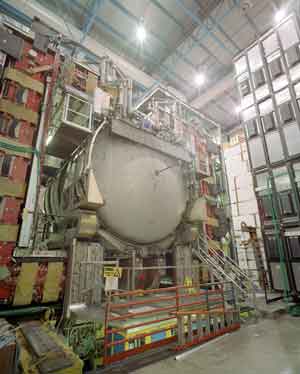 Physicists have been searching for dark matter — the substance that makes up most of the matter in the universe — for decades. Now an international collaboration of physicists working in an abandoned mine in Minnesota have announced there’s a chance they may have spotted a glimpse of the subatomic particles.
Physicists have been searching for dark matter — the substance that makes up most of the matter in the universe — for decades. Now an international collaboration of physicists working in an abandoned mine in Minnesota have announced there’s a chance they may have spotted a glimpse of the subatomic particles.
One of two scientists presenting the finding simultaneously on opposite coasts was physicist Jodi Cooley, an SMU assistant professor of experimental particle physics.
![]() The New York Times and Scientific American, among others, were there to take note. The Times article “At a Mine’s Bottom, Hints of Dark Matter” was reported by Dennis Overbye and was published in the Dec. 17 edition of The Times.
The New York Times and Scientific American, among others, were there to take note. The Times article “At a Mine’s Bottom, Hints of Dark Matter” was reported by Dennis Overbye and was published in the Dec. 17 edition of The Times.
Scientific American‘s John Matson reported the story in “Dark Matter Researchers Still in the Dark as Underground Search Returns Uncertain Results” also on Dec. 17.
Excerpt:
By DENNIS OVERBYE
The New York Times
An international team of physicists working in the bottom of an old iron mine in Minnesota said Thursday that they might have registered the first faint hints of a ghostly sea of subatomic particles known as dark matter long thought to permeate the cosmos.
More SMU Research New Paluxysaurus mount 3D dinosaur track Hunt for Higgs boson The particles showed as two tiny pulses of heat deposited over the course of two years in chunks of germanium and silicon that had been cooled to a temperature near absolute zero. But, the scientists said, there was more than a 20 percent chance that the pulses were caused by fluctuations in the background radioactivity of their cavern, so the results were tantalizing, but not definitive.
Gordon Kane, a physicist from the University of Michigan, called the results “inconclusive, sadly,” adding, “It seems likely it is dark matter detection, but no proof.”
Dr. Kane said results from bigger and thus more sensitive experiments would be available in a couple of months.
The team, known as the Cryogenic Dark Matter Search, announced its results in a pair of simultaneous talks by Jodi Cooley from Southern Methodist University at the SLAC National Acceleratory Laboratory in California and by Lauren Hsu of the Fermi National Accelerator Laboratory in Illinois at Fermilab, and they say they plan to post a paper on the Internet.
Excerpt:
By JOHN MATSON
Scientific American
A hotly anticipated announcement regarding a possible signature of dark matter delivered some grist for the physics mill Thursday but failed to produce the blockbuster result some had predicted. In a Webcast talk from Stanford University, Jodi Cooley, a particle physicist at Southern Methodist University, presented the latest results from the Cryogenic Dark Matter Search 2 (CDMS-2), a series of detectors buried deep underground in a former iron mine in northern Minnesota. (The first CDMS experiment was located at Stanford, much closer to the surface.) CDMS-2, she said, detected two signals that fit the bill for the passage of dark matter particles, but other possibilities could not be ruled out.Dark matter is thought to make up roughly a quarter of the universe but has never been directly observed. In present-day estimates of the universe’s makeup, ordinary atoms (such as those we detect as the visible universe) contribute only about 5 percent; the bulk of the cosmos takes the form of so-called dark energy, under whose influence the universe is expanding at an increasing clip. Dark matter’s presence has for decades been inferred from its gravitational effects on large-scale structures such as galaxy clusters, but because it does not interact much with ordinary matter and does not emit or absorb light — hence the “dark” moniker — it has so far proved impossible to observe firsthand.
Read “Dark Matter Researchers Still in the Dark as Underground Search Returns Uncertain Results“
Other coverage:
Live blogging: Discover
Science News
U.S. News & World Report
The Seattle Times
Related links:
CDMS: Lay explanation of the research findings
Video: Jodi Cooley announcing from SLAC
Jodi Cooley
Symmetry Magazine: Dark Matter Experiment Results Announced
Fermilab: Dark matter and supersymmetry FAQ
Fermilab images: Cryogenic Dark Matter Search
Fermi National Accelerator Laboratory
CERN: Recipe for a Universe
Nobel Prize: Why is there something instead of nothing?
Fermilab: Dark Universe Debate
ATLAS
CERN FAQ
SMU Department of Physics
Dedman College of Humanities and Sciences
 Physicists have been searching for
Physicists have been searching for 

